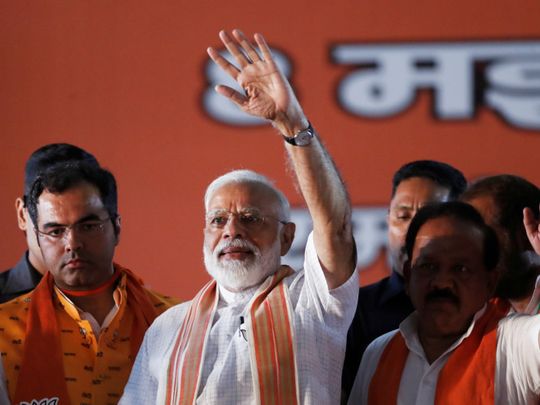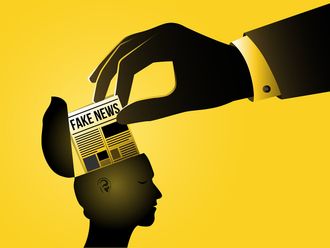
Since coming to power in 2014, Narendra Modi, the prime minister of India, has assiduously centralised and personalised power. His critics often refer to his term in office as an “undeclared emergency”.
The phrase evokes comparison with the period between June 1975 and March 1977 when Prime Minister Indira Gandhi suspended constitutional rights and imposed her authoritarian will on the polity after claiming that India needed the “shock treatment” to combat its enemies. That dark period, which saw Gandhi assume extraordinary powers, jail opposition leaders and silence the press, is known in India as the Emergency.
Modi has ruled India with the iron will reminiscent of Gandhi. He brooks no dissent and projects the personality cult of a strong Hindu nationalist warrior combating the nation’s internal and external enemies with “surgical strikes.” His supporters vociferously endorse this cult and throng his campaign events wearing Modi masks. The results of the continuing Indian elections on May 23 will reveal whether India will endorse Modi or spurn him as they did Gandhi in the 1977 elections after the Emergency.
Gandhi was the last leader who even remotely achieved the popularity and authority in Indian politics presently enjoyed by Modi. She came to power two years after the death of her father, Prime Minister Jawaharlal Nehru, who led India from its independence in 1947 until his death in 1964. As Nehru’s only child and confidante during his 17 years in office, Gandhi came to know leaders and intellectuals around the world. Unlike Modi, she was secular, cosmopolitan, spoke several languages and took a keen interest in the arts.
The ruling Indian National Congress bosses appointed the 49-year-old Gandhi prime minister when her father’s successor died unexpectedly in 1966. They had hoped that she would be their pliable instrument. But Gandhi adopted a pro-poor populist rhetoric and ousted the old bosses to become the unquestioned leader of the Congress party by 1969. After she defeated the opposition in general elections in March 1971, her popularity and authority soared.
Gandhi’s stature reached a pinnacle when she led India in a successful December 1971 war against Pakistan. After the war, which led to the formation of Bangladesh, Gandhi was likened to the Hindu deity Durga, the slayer of demons. Even veteran politicians dissolved into sycophants around her.
Insecure, distrustful
In spite of her unprecedented authority, Gandhi was insecure and distrustful, and had little patience for defiance. A serious challenge to her authority emerged after protests against increasing food prices in 1974 snowballed into a powerful student and youth movement led by Jayaprakash Narayan, a 72-year-old socialist politician and follower of Mahatma Gandhi.
On June 12, 1975, a court found Gandhi guilty of the electoral malpractice of using government machinery during the 1971 election, invalidated her victory and barred her from political office for six years. In her eyes, the internal agents of the “foreign hand” — a phrase she coined and used to refer to hostile foreign powers — had struck. Thirteen days later, she responded by declaring a state of emergency.
During the next 21 months, Gandhi gave the police a free hand in arresting, intimidating and torturing political opponents. Most egregious of all was a coercive vasectomy drive to control population growth.
Gandhi tried to sheath her authoritarian regime with a veneer of lawful authority by ratcheting up the use of existing laws of preventive detention and police powers. Though authoritarianism secured her power, its stigma stung. She ordered national elections in 1977 believing that Indians would reward her for instilling discipline. India rejected her decisively.
There is no formal declaration of emergency, no official press censorship, no suppression of political parties in Modi’s India. Yet Modi exercises authoritarian power, and his personality looms larger on the Indian political landscape than Gandhi’s ever did.
Riding to power in 2014 with an overwhelming majority for his Hindu nationalist Bharatiya Janata Party, Modi quickly moved to centralise power. His government bypassed the Parliament and issued ordinances to advance his policies. Civil society organisations have faced investigations. Unqualified Hindu nationalists were foisted on educational and cultural institutions. A law was instituted to exert greater control over the appointment of judges.
Constitutions centralising provisions
Aiding Modi’s autocratic drive are the centralising provisions of the Indian Constitution. Introduced in 1950, the constitution imported the bulk of coercive British colonial laws. They include the notorious 1870 sedition law that the government uses against its “anti-national” critics. Extraordinary laws enacted to suppress the insurgency in Kashmir and elsewhere remain in force.
Long-standing police practices, preceding even Gandhi’s Emergency, aiming to intimidate and harass critics persist with a vengeance. Such undemocratic practices and legacies have acquired an ominous new life with the ascendance of Modi and his Hindu nationalist party.
While Gandhi resorted to emergency rule to survive a political crisis, Modi’s regime thrives on Hindu majoritarian militancy. He stokes majoritarian resentments against the minorities to further his rule. Dissent is denounced as treason, and Hindu nationalists deride critics as elites guilty of “rootless cosmopolitanism.” Violent attacks on minorities have become common. Several intellectuals and journalists have been killed by Hindu extremists.
The cult of Narendra Modi dominates Indian politics. Most of India’s private television networks relentlessly boost his image and divisive message for higher ratings and to protect their privileges.
Less than 10 years ago, the Bharatiya Janata Party (BJP) had a galaxy of seasoned leaders, but today Modi embodies the party. His photographs, slogans and programmes appear everywhere. There are an app and a television network named after him: the NaMo app and NaMo TV. He has not held a single news conference in five years, claiming that he prefers speaking directly to the people with a weekly monologue on state radio and, like President Donald Trump, with tweets.
Yet a few months back, Modi was on the ropes, having failed to create jobs or boost India’s struggling agriculture sector. To cover up his failures, Modi is running an electoral campaign whipping up militaristic sentiments against Pakistan and full of dog whistles against India’s Muslims. His party even nominated a Hindu nationalist politician, who is facing trial for a 2008 terrorist attack on Muslims, as one of its candidates.
With an authoritarian, hyper nationalist warrior asking for their support, Indian voters are tasked with making a consequential choice for India’s future. As B.R. Ambedkar, the great Dalit leader and the architect of India’s Constitution, once remarked, Indians were particularly susceptible to “bhakti,” or “devotion.” This was fine in religion, but in politics, he warned, it is “a sure road to degradation and eventual dictatorship.”
— New York Times News Service
Gyan Prakash teaches history at Princeton University and is the author of ‘Emergency Chronicles: Indira Gandhi and Democracy’s Turning Point.’










